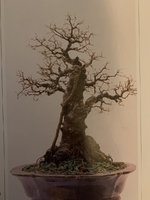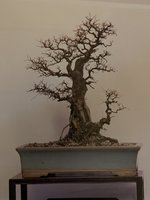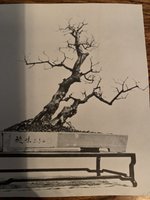Other folks who eschew wiring as a method and rely soley on clip and grow tend to attract controversy, like Nigel Saunders
And Nigel's trees - ***IMO*** - are WAYYYYYYY inferior to his passion, the time & effort he's put in, etc....I don't like to disparage & know this is an ugly thing to say but I've virtually given up on ever watching his vids because of crap like 1" trunked ficus benji's and other things that simply don't make sense as bonsai yet he's already doing clip&grow (despite the absence of any real skeleton/structure in the tree yet IE the thing still just needs grow-out yet he's working Refinement...)
Clip&Grow, as I understand it, means a doing prune jobs that are "reduction cuts" IE cutting-back to a fork/union/node, and "directing the growth over time"....the time required to do this well would automatically limit a FULL-TIME artist to a seriously low # of specimen...
BUT what of W.Pall's "hedge pruning" method? Silhouette/hedge prune approaches -- IMO -- achieve comparable results to clip&grow, only - because they're allowing far more growth-per-year - they achieve the results quicker. Sure, you've grown-out a bush, not a well-defined tree structure, but
then you simply go do your "clipping" to make it the shape you want, the "growing" part is already done. Nevermind that this lets you treat/work many dozens, even over 100, specimen in your nursery!
~~~~~~~~~~~~
This seems as good a spot as any to propose/explain a method I do or "created", I'm gonna go and call it
"Bend & Grow", basically on some of my specimen that I WOULD have done clip&grow (yes I do have a handful that are/were done this way),
instead of doing the clip to direct growth, I'd simply wire or guy-wire the limb/branch/twig at the spot I
would've clipped/cut it. Due to the apical / tip-growth nature of trees, if you bring a stem's growing tip below horizontal, you
get to keep all those resources, all the solar panels of the leaves, AND the tree responds by budding at the first node before the downward bend as-if you'd simply cut it at the bend!!!"
Obviously this isn't something unknown (that bending below horizontal causes hormonal reactions where the tree "chooses a new apical tip for that branch now"), but using it instead-of simply cutting lets you keep so much more tissue/mass/solar-panels on that limb that it greatly exaggerates growth of that limb (and when, 1-2yrs later you actually do go in and do some hard-prunes, you have absurd/significant taper from union to union





